Tesla's Battery Project in South Australia
VerifiedAdded on 2020/03/16
|8
|2053
|46
AI Summary
This assignment delves into Tesla's groundbreaking project to build the world's biggest lithium-ion battery in South Australia. It examines the reasons behind the project, its potential impact on the state's electricity grid stability, and its contribution to South Australia's ambitious renewable energy targets. Various news articles and government reports provide insights into the project's details, implications, and the broader context of renewable energy adoption in the region.
Contribute Materials
Your contribution can guide someone’s learning journey. Share your
documents today.
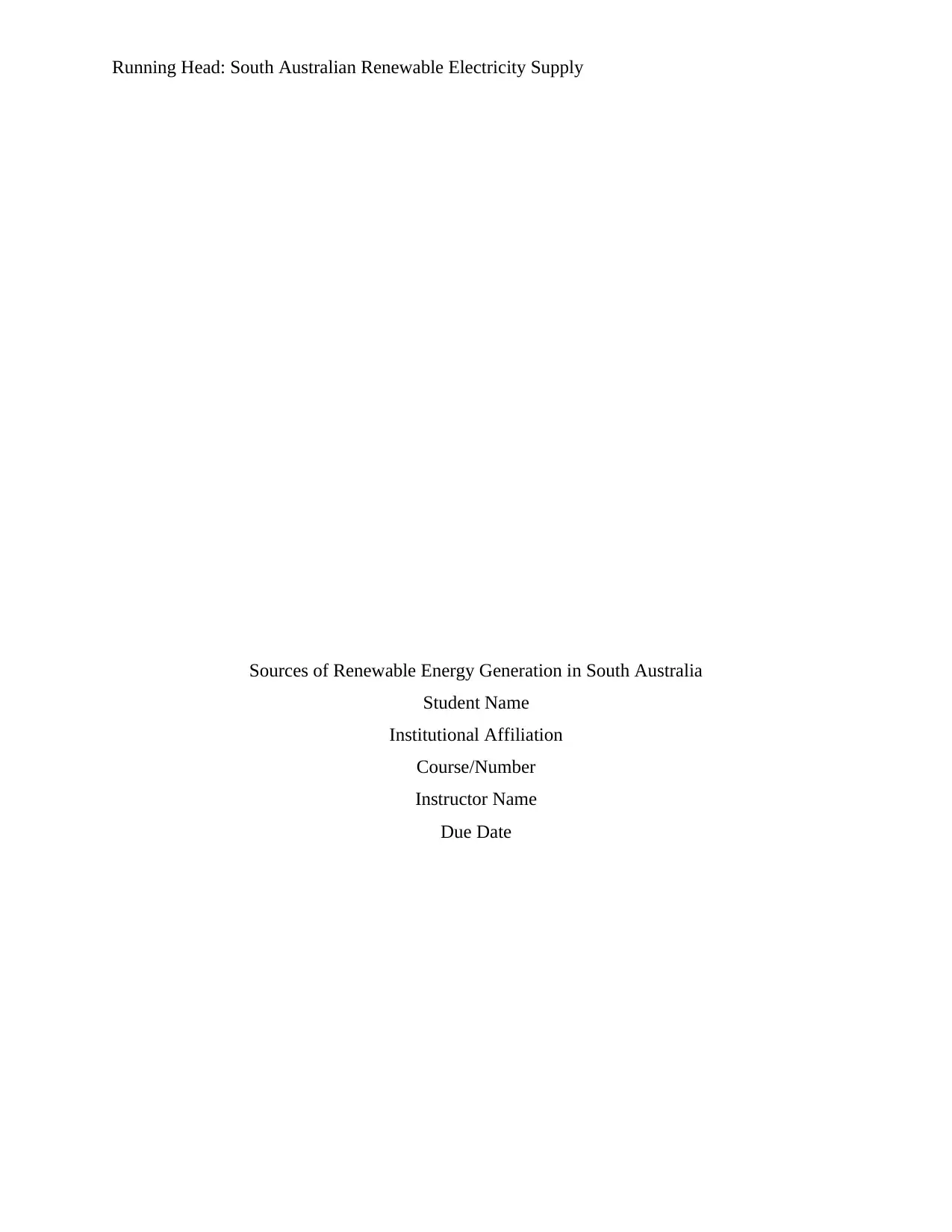
Running Head: South Australian Renewable Electricity Supply
Sources of Renewable Energy Generation in South Australia
Student Name
Institutional Affiliation
Course/Number
Instructor Name
Due Date
Sources of Renewable Energy Generation in South Australia
Student Name
Institutional Affiliation
Course/Number
Instructor Name
Due Date
Secure Best Marks with AI Grader
Need help grading? Try our AI Grader for instant feedback on your assignments.
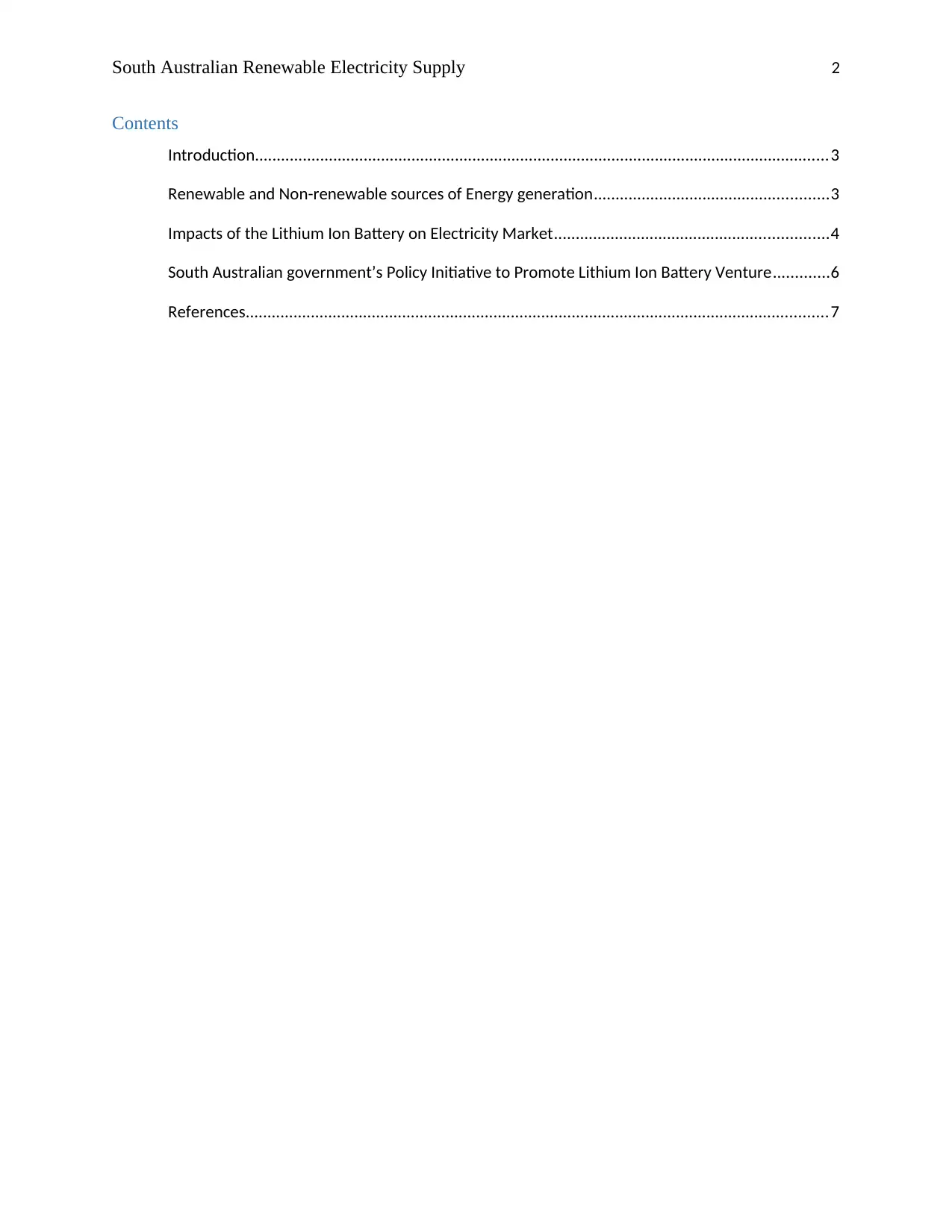
South Australian Renewable Electricity Supply 2
Contents
Introduction....................................................................................................................................3
Renewable and Non-renewable sources of Energy generation......................................................3
Impacts of the Lithium Ion Battery on Electricity Market...............................................................4
South Australian government’s Policy Initiative to Promote Lithium Ion Battery Venture.............6
References......................................................................................................................................7
Contents
Introduction....................................................................................................................................3
Renewable and Non-renewable sources of Energy generation......................................................3
Impacts of the Lithium Ion Battery on Electricity Market...............................................................4
South Australian government’s Policy Initiative to Promote Lithium Ion Battery Venture.............6
References......................................................................................................................................7

South Australian Renewable Electricity Supply 3
Sources of Renewable Energy Generation in South Australia
Introduction
There are both renewable and non-renewable sources of electricity generation in
Southern Australia. A renewable source of energy depletion is the one that replenishes fast upon
consumption; the supply does not deplete from consumption. On the other hand, a non-
renewable source depletes with consumption since the replenish rate is low; this means that
supply is limited. These sources contributes with varying proportion to electricity in the market.
This paper shall determine both of these sources and also determine their proportion of
contribution in the market. There is increase need for a shift to renewable sources of energy
(Zahar, Peel & Godden, 2013).One of the most important renewable source of energy to be
covered in this paper is the Lithium ion battery. The introduction of this storage of lithium ion
Battery will have a positive impact on the supply for electricity in Australia. The paper will
elaborate such changes and will discuss the need for the government to support this venture. The
paper tells us that this supply will increase the proportion of contribution for the renewable
sources in the future. We shall also identify the potential change in price of electricity in the
market after the complete integration of this storage system.
Renewable and Non-renewable sources of Energy generation
Some of the South Australian sources of renewable energy generation includes solar and
wind; the solar energy is obtained from the rooftops by the use of solar Photovoltaic (PV)
systems (Sa.gov.au, 2017). These solar system are dependent on sunlight; the number of South
Australian households who have installed the solar rooftop PVs are more than 200,000. The
electricity produced through these systems is used by the households and the excess is sent to
main electricity grid. The South Australian wind farms are dependent on wind and when wind is
strong there is an increased generation of electricity for the customers.
Some of the South Australian sources of non-renewable energy generation includes
natural gas and diesel. The main source on non-renewable source is the natural gas where
approximately 60% of the total South Australian natural gas is used for electricity generation.
The supply that is obtained from power stations that are fired by diesel is relatively small. The
stations are small are mostly are in operation only during the period of peak demand for
electricity.
Sources of Renewable Energy Generation in South Australia
Introduction
There are both renewable and non-renewable sources of electricity generation in
Southern Australia. A renewable source of energy depletion is the one that replenishes fast upon
consumption; the supply does not deplete from consumption. On the other hand, a non-
renewable source depletes with consumption since the replenish rate is low; this means that
supply is limited. These sources contributes with varying proportion to electricity in the market.
This paper shall determine both of these sources and also determine their proportion of
contribution in the market. There is increase need for a shift to renewable sources of energy
(Zahar, Peel & Godden, 2013).One of the most important renewable source of energy to be
covered in this paper is the Lithium ion battery. The introduction of this storage of lithium ion
Battery will have a positive impact on the supply for electricity in Australia. The paper will
elaborate such changes and will discuss the need for the government to support this venture. The
paper tells us that this supply will increase the proportion of contribution for the renewable
sources in the future. We shall also identify the potential change in price of electricity in the
market after the complete integration of this storage system.
Renewable and Non-renewable sources of Energy generation
Some of the South Australian sources of renewable energy generation includes solar and
wind; the solar energy is obtained from the rooftops by the use of solar Photovoltaic (PV)
systems (Sa.gov.au, 2017). These solar system are dependent on sunlight; the number of South
Australian households who have installed the solar rooftop PVs are more than 200,000. The
electricity produced through these systems is used by the households and the excess is sent to
main electricity grid. The South Australian wind farms are dependent on wind and when wind is
strong there is an increased generation of electricity for the customers.
Some of the South Australian sources of non-renewable energy generation includes
natural gas and diesel. The main source on non-renewable source is the natural gas where
approximately 60% of the total South Australian natural gas is used for electricity generation.
The supply that is obtained from power stations that are fired by diesel is relatively small. The
stations are small are mostly are in operation only during the period of peak demand for
electricity.

South Australian Renewable Electricity Supply 4
Fig: Renewable and Non-renewable contribution to South Australian electricity
57%
43%
Contribution of renewable and non-renewable
sources of electricity in SA
Renewable source Non-renewable source
South Australian government had in plan a target to achieve a 50% contribution of energy
from renewable sources in the future 2025 (Abc.net.au, 2017). However, the last contribution of
this renewable source (wind and solar) was already beyond 50%. According to Wills (2017),
Premier Jay Weatherill’s target of Australia achieving a 50% renewable energy by 2025 was
achieved eight years earlier; the proportion of renewable source at April 2017 was 53% which
left 47% to be obtained from non-renewable sources. However, the article presented by
Parkinson (2017) noted that the contribution by renewable sources was 57% which left only 43$
to be obtained from non-renewable sources; this is the data that is presented in the pie chart
above. The contribution of wind power to the 2015/16 states demand was approximately 38%;
this contribution jumped in 2016 and a further jump in 2017. Snowtown and Hornsdale are the
two wind farms that came on line to raise the contribution of wind power. Non0renewable
sources of energy such as carbon, coal and oil were on an increased criticize due to the alarming
degradation of the environment from their consumption. The goal of the Australian government
is to lower the contribution of non-renewable sources to the minimum level possible and active a
100% supply of renewable energy in the future (Diesendorf, 2017).
Impacts of the Lithium Ion Battery on Electricity Market
The main aim of the building of South Australian world’s largest Lithium ion battery was
for securing power (Scopelianos, Fedorowytsch & Garcia, 2017). The battery will be an all-time
stabilizer of the power network and in case of a shortfall it will provide some backup power. This
Fig: Renewable and Non-renewable contribution to South Australian electricity
57%
43%
Contribution of renewable and non-renewable
sources of electricity in SA
Renewable source Non-renewable source
South Australian government had in plan a target to achieve a 50% contribution of energy
from renewable sources in the future 2025 (Abc.net.au, 2017). However, the last contribution of
this renewable source (wind and solar) was already beyond 50%. According to Wills (2017),
Premier Jay Weatherill’s target of Australia achieving a 50% renewable energy by 2025 was
achieved eight years earlier; the proportion of renewable source at April 2017 was 53% which
left 47% to be obtained from non-renewable sources. However, the article presented by
Parkinson (2017) noted that the contribution by renewable sources was 57% which left only 43$
to be obtained from non-renewable sources; this is the data that is presented in the pie chart
above. The contribution of wind power to the 2015/16 states demand was approximately 38%;
this contribution jumped in 2016 and a further jump in 2017. Snowtown and Hornsdale are the
two wind farms that came on line to raise the contribution of wind power. Non0renewable
sources of energy such as carbon, coal and oil were on an increased criticize due to the alarming
degradation of the environment from their consumption. The goal of the Australian government
is to lower the contribution of non-renewable sources to the minimum level possible and active a
100% supply of renewable energy in the future (Diesendorf, 2017).
Impacts of the Lithium Ion Battery on Electricity Market
The main aim of the building of South Australian world’s largest Lithium ion battery was
for securing power (Scopelianos, Fedorowytsch & Garcia, 2017). The battery will be an all-time
stabilizer of the power network and in case of a shortfall it will provide some backup power. This
Secure Best Marks with AI Grader
Need help grading? Try our AI Grader for instant feedback on your assignments.
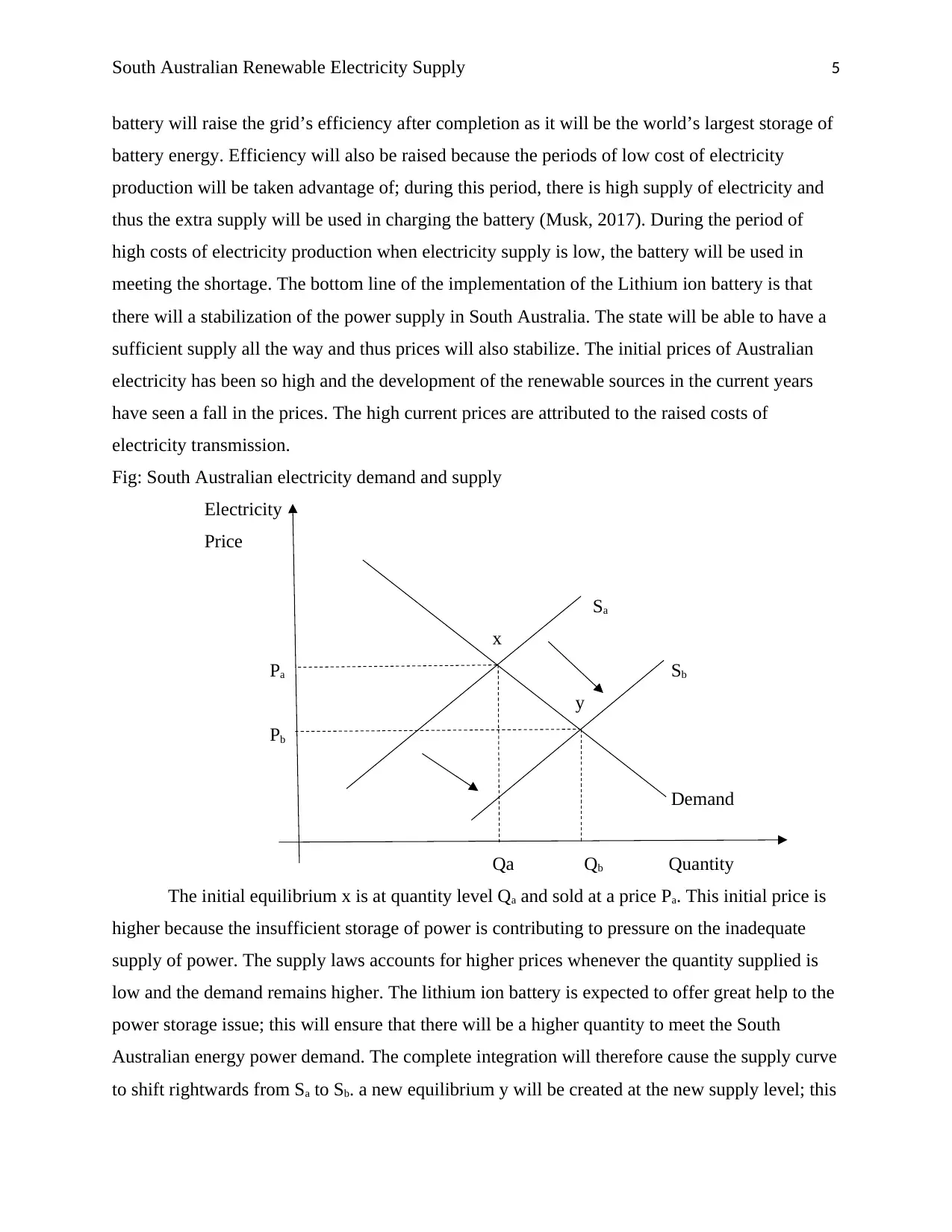
South Australian Renewable Electricity Supply 5
battery will raise the grid’s efficiency after completion as it will be the world’s largest storage of
battery energy. Efficiency will also be raised because the periods of low cost of electricity
production will be taken advantage of; during this period, there is high supply of electricity and
thus the extra supply will be used in charging the battery (Musk, 2017). During the period of
high costs of electricity production when electricity supply is low, the battery will be used in
meeting the shortage. The bottom line of the implementation of the Lithium ion battery is that
there will a stabilization of the power supply in South Australia. The state will be able to have a
sufficient supply all the way and thus prices will also stabilize. The initial prices of Australian
electricity has been so high and the development of the renewable sources in the current years
have seen a fall in the prices. The high current prices are attributed to the raised costs of
electricity transmission.
Fig: South Australian electricity demand and supply
Electricity
Price
Sa
x
Pa Sb
y
Pb
Demand
Qa Qb Quantity
The initial equilibrium x is at quantity level Qa and sold at a price Pa. This initial price is
higher because the insufficient storage of power is contributing to pressure on the inadequate
supply of power. The supply laws accounts for higher prices whenever the quantity supplied is
low and the demand remains higher. The lithium ion battery is expected to offer great help to the
power storage issue; this will ensure that there will be a higher quantity to meet the South
Australian energy power demand. The complete integration will therefore cause the supply curve
to shift rightwards from Sa to Sb. a new equilibrium y will be created at the new supply level; this
battery will raise the grid’s efficiency after completion as it will be the world’s largest storage of
battery energy. Efficiency will also be raised because the periods of low cost of electricity
production will be taken advantage of; during this period, there is high supply of electricity and
thus the extra supply will be used in charging the battery (Musk, 2017). During the period of
high costs of electricity production when electricity supply is low, the battery will be used in
meeting the shortage. The bottom line of the implementation of the Lithium ion battery is that
there will a stabilization of the power supply in South Australia. The state will be able to have a
sufficient supply all the way and thus prices will also stabilize. The initial prices of Australian
electricity has been so high and the development of the renewable sources in the current years
have seen a fall in the prices. The high current prices are attributed to the raised costs of
electricity transmission.
Fig: South Australian electricity demand and supply
Electricity
Price
Sa
x
Pa Sb
y
Pb
Demand
Qa Qb Quantity
The initial equilibrium x is at quantity level Qa and sold at a price Pa. This initial price is
higher because the insufficient storage of power is contributing to pressure on the inadequate
supply of power. The supply laws accounts for higher prices whenever the quantity supplied is
low and the demand remains higher. The lithium ion battery is expected to offer great help to the
power storage issue; this will ensure that there will be a higher quantity to meet the South
Australian energy power demand. The complete integration will therefore cause the supply curve
to shift rightwards from Sa to Sb. a new equilibrium y will be created at the new supply level; this

South Australian Renewable Electricity Supply 6
new equilibrium will be characterized by a lower price level and a higher quantity level.
Consumers will therefore pay lower prices for power consumption and the pressure on South
Australian energy prices will be lowered (Pham, 2017). The impact of the implementation of the
Lithium ion battery will therefore be to lower consumer prices and raise energy supply.
South Australian government’s Policy Initiative to Promote Lithium Ion Battery Venture
The government of Australia may play an important part of developing the renewable
energy industry. This could be by an increased investment in this industry through an increased
level of funding. Weatherill (2017) noted that South Australian government announced in March
2017 a plan to make the sate more self-reliant by taking charge of its energy security in the
future. The major reason why the government is concerned with the energy industry and thus
need to impose policy measure is because the South Australian state faced statewide blackout on
September 2016 and has been constantly facing widespread load shedding (Harmsen &
McMahon, 2017). There is therefore an increased need to achieve a stable power supply at all
costs. There is a planned $500 million for expanding the Australian energy industry, the
government can allocate a significant amount of money to the building of the Lithium ion battery
as it would contribute to the increased provision of renewable power which is the government’s
future goals. Dunn (2017) noted that the government already has in place $150 million set aside
for renewable energy; it could add an extra spending to make this sum sufficient to complete the
construction of this battery. It is stated that the projects costs would rise by $50 million if this
project is not completed on the stated schedule.
The government should ensure that this project is completed on time by funding the
project significantly. It could also ensure that the costs of building the battery is lowered by
lowering the taxation rate for the low materials used in the building of this battery. The
government should ensure that signing of the grid interconnection agreement is done as soon as
possible to enable Tesla to complete the project before summer. The proposers of this project had
planned to complete it before 1st Decembers 2017. The major argument behind the increased
government funding is to ensure that the government will have complete ownership of this
battery in order to be able to stabilize prices easily. Private ownership would cost the government
extra spending since at time it would be required to subsidize the supply coming from the battery
for supply to be made at a lower price. Therefore it can be concluded that fiscal policy of
increased government spending would be the essential policy to support this venture.
new equilibrium will be characterized by a lower price level and a higher quantity level.
Consumers will therefore pay lower prices for power consumption and the pressure on South
Australian energy prices will be lowered (Pham, 2017). The impact of the implementation of the
Lithium ion battery will therefore be to lower consumer prices and raise energy supply.
South Australian government’s Policy Initiative to Promote Lithium Ion Battery Venture
The government of Australia may play an important part of developing the renewable
energy industry. This could be by an increased investment in this industry through an increased
level of funding. Weatherill (2017) noted that South Australian government announced in March
2017 a plan to make the sate more self-reliant by taking charge of its energy security in the
future. The major reason why the government is concerned with the energy industry and thus
need to impose policy measure is because the South Australian state faced statewide blackout on
September 2016 and has been constantly facing widespread load shedding (Harmsen &
McMahon, 2017). There is therefore an increased need to achieve a stable power supply at all
costs. There is a planned $500 million for expanding the Australian energy industry, the
government can allocate a significant amount of money to the building of the Lithium ion battery
as it would contribute to the increased provision of renewable power which is the government’s
future goals. Dunn (2017) noted that the government already has in place $150 million set aside
for renewable energy; it could add an extra spending to make this sum sufficient to complete the
construction of this battery. It is stated that the projects costs would rise by $50 million if this
project is not completed on the stated schedule.
The government should ensure that this project is completed on time by funding the
project significantly. It could also ensure that the costs of building the battery is lowered by
lowering the taxation rate for the low materials used in the building of this battery. The
government should ensure that signing of the grid interconnection agreement is done as soon as
possible to enable Tesla to complete the project before summer. The proposers of this project had
planned to complete it before 1st Decembers 2017. The major argument behind the increased
government funding is to ensure that the government will have complete ownership of this
battery in order to be able to stabilize prices easily. Private ownership would cost the government
extra spending since at time it would be required to subsidize the supply coming from the battery
for supply to be made at a lower price. Therefore it can be concluded that fiscal policy of
increased government spending would be the essential policy to support this venture.
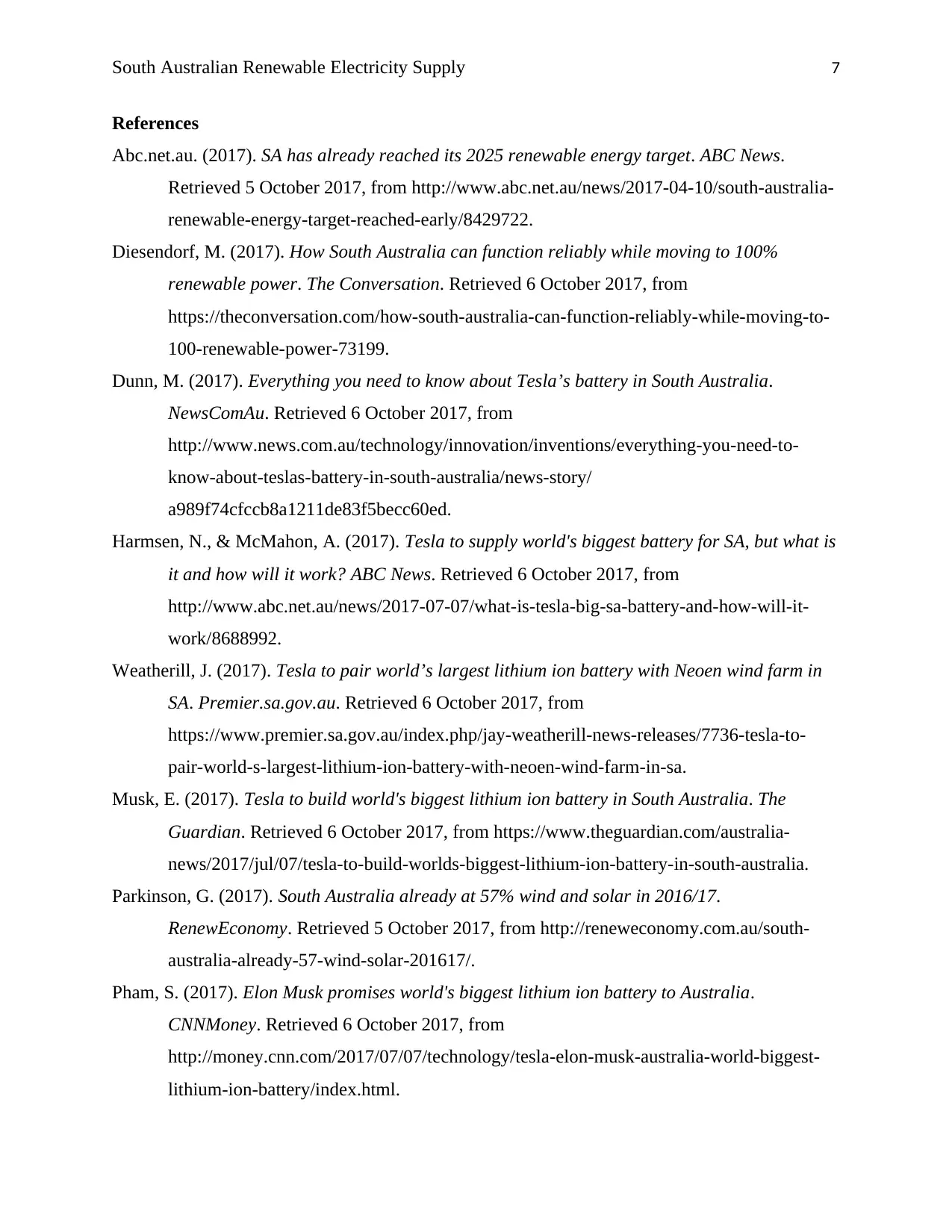
South Australian Renewable Electricity Supply 7
References
Abc.net.au. (2017). SA has already reached its 2025 renewable energy target. ABC News.
Retrieved 5 October 2017, from http://www.abc.net.au/news/2017-04-10/south-australia-
renewable-energy-target-reached-early/8429722.
Diesendorf, M. (2017). How South Australia can function reliably while moving to 100%
renewable power. The Conversation. Retrieved 6 October 2017, from
https://theconversation.com/how-south-australia-can-function-reliably-while-moving-to-
100-renewable-power-73199.
Dunn, M. (2017). Everything you need to know about Tesla’s battery in South Australia.
NewsComAu. Retrieved 6 October 2017, from
http://www.news.com.au/technology/innovation/inventions/everything-you-need-to-
know-about-teslas-battery-in-south-australia/news-story/
a989f74cfccb8a1211de83f5becc60ed.
Harmsen, N., & McMahon, A. (2017). Tesla to supply world's biggest battery for SA, but what is
it and how will it work? ABC News. Retrieved 6 October 2017, from
http://www.abc.net.au/news/2017-07-07/what-is-tesla-big-sa-battery-and-how-will-it-
work/8688992.
Weatherill, J. (2017). Tesla to pair world’s largest lithium ion battery with Neoen wind farm in
SA. Premier.sa.gov.au. Retrieved 6 October 2017, from
https://www.premier.sa.gov.au/index.php/jay-weatherill-news-releases/7736-tesla-to-
pair-world-s-largest-lithium-ion-battery-with-neoen-wind-farm-in-sa.
Musk, E. (2017). Tesla to build world's biggest lithium ion battery in South Australia. The
Guardian. Retrieved 6 October 2017, from https://www.theguardian.com/australia-
news/2017/jul/07/tesla-to-build-worlds-biggest-lithium-ion-battery-in-south-australia.
Parkinson, G. (2017). South Australia already at 57% wind and solar in 2016/17.
RenewEconomy. Retrieved 5 October 2017, from http://reneweconomy.com.au/south-
australia-already-57-wind-solar-201617/.
Pham, S. (2017). Elon Musk promises world's biggest lithium ion battery to Australia.
CNNMoney. Retrieved 6 October 2017, from
http://money.cnn.com/2017/07/07/technology/tesla-elon-musk-australia-world-biggest-
lithium-ion-battery/index.html.
References
Abc.net.au. (2017). SA has already reached its 2025 renewable energy target. ABC News.
Retrieved 5 October 2017, from http://www.abc.net.au/news/2017-04-10/south-australia-
renewable-energy-target-reached-early/8429722.
Diesendorf, M. (2017). How South Australia can function reliably while moving to 100%
renewable power. The Conversation. Retrieved 6 October 2017, from
https://theconversation.com/how-south-australia-can-function-reliably-while-moving-to-
100-renewable-power-73199.
Dunn, M. (2017). Everything you need to know about Tesla’s battery in South Australia.
NewsComAu. Retrieved 6 October 2017, from
http://www.news.com.au/technology/innovation/inventions/everything-you-need-to-
know-about-teslas-battery-in-south-australia/news-story/
a989f74cfccb8a1211de83f5becc60ed.
Harmsen, N., & McMahon, A. (2017). Tesla to supply world's biggest battery for SA, but what is
it and how will it work? ABC News. Retrieved 6 October 2017, from
http://www.abc.net.au/news/2017-07-07/what-is-tesla-big-sa-battery-and-how-will-it-
work/8688992.
Weatherill, J. (2017). Tesla to pair world’s largest lithium ion battery with Neoen wind farm in
SA. Premier.sa.gov.au. Retrieved 6 October 2017, from
https://www.premier.sa.gov.au/index.php/jay-weatherill-news-releases/7736-tesla-to-
pair-world-s-largest-lithium-ion-battery-with-neoen-wind-farm-in-sa.
Musk, E. (2017). Tesla to build world's biggest lithium ion battery in South Australia. The
Guardian. Retrieved 6 October 2017, from https://www.theguardian.com/australia-
news/2017/jul/07/tesla-to-build-worlds-biggest-lithium-ion-battery-in-south-australia.
Parkinson, G. (2017). South Australia already at 57% wind and solar in 2016/17.
RenewEconomy. Retrieved 5 October 2017, from http://reneweconomy.com.au/south-
australia-already-57-wind-solar-201617/.
Pham, S. (2017). Elon Musk promises world's biggest lithium ion battery to Australia.
CNNMoney. Retrieved 6 October 2017, from
http://money.cnn.com/2017/07/07/technology/tesla-elon-musk-australia-world-biggest-
lithium-ion-battery/index.html.
Paraphrase This Document
Need a fresh take? Get an instant paraphrase of this document with our AI Paraphraser
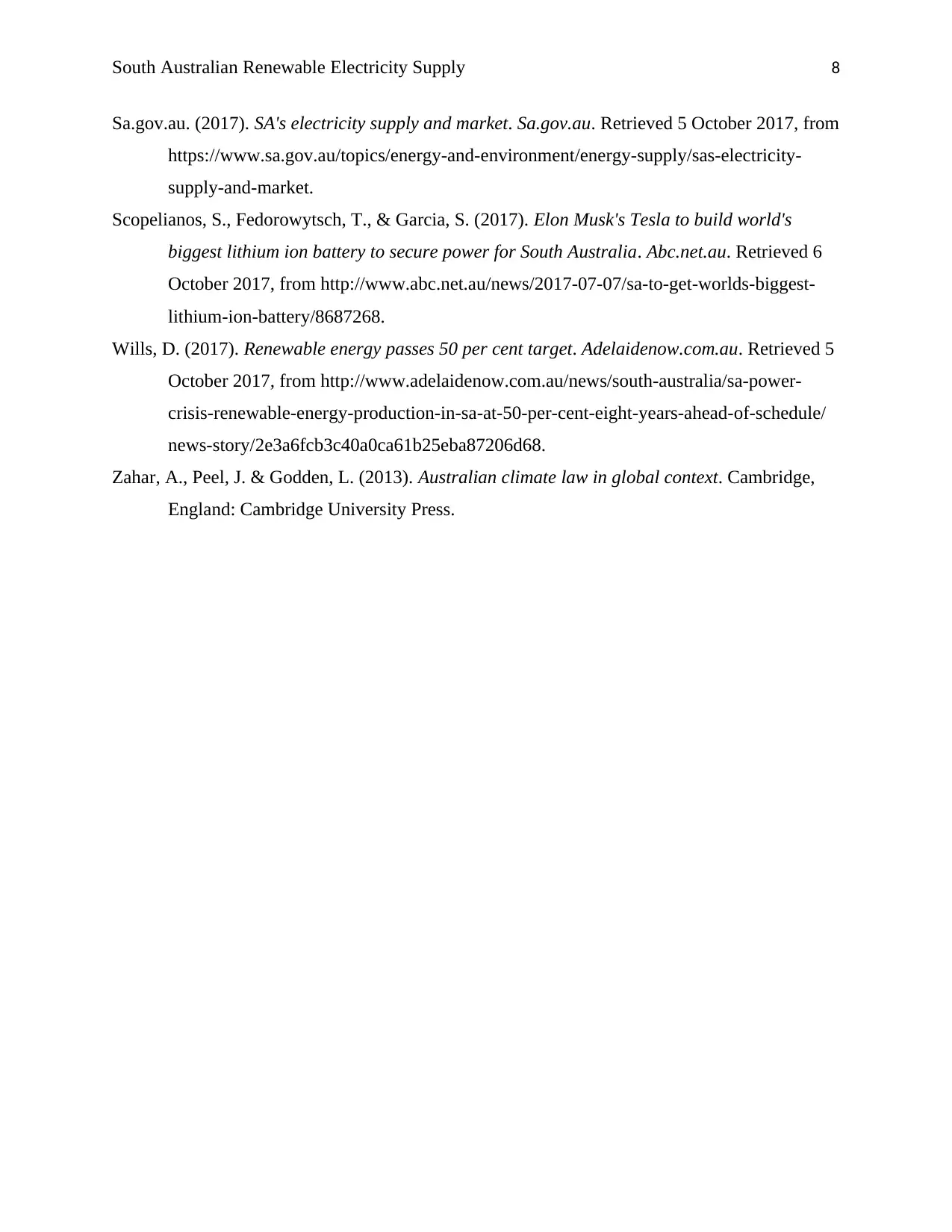
South Australian Renewable Electricity Supply 8
Sa.gov.au. (2017). SA's electricity supply and market. Sa.gov.au. Retrieved 5 October 2017, from
https://www.sa.gov.au/topics/energy-and-environment/energy-supply/sas-electricity-
supply-and-market.
Scopelianos, S., Fedorowytsch, T., & Garcia, S. (2017). Elon Musk's Tesla to build world's
biggest lithium ion battery to secure power for South Australia. Abc.net.au. Retrieved 6
October 2017, from http://www.abc.net.au/news/2017-07-07/sa-to-get-worlds-biggest-
lithium-ion-battery/8687268.
Wills, D. (2017). Renewable energy passes 50 per cent target. Adelaidenow.com.au. Retrieved 5
October 2017, from http://www.adelaidenow.com.au/news/south-australia/sa-power-
crisis-renewable-energy-production-in-sa-at-50-per-cent-eight-years-ahead-of-schedule/
news-story/2e3a6fcb3c40a0ca61b25eba87206d68.
Zahar, A., Peel, J. & Godden, L. (2013). Australian climate law in global context. Cambridge,
England: Cambridge University Press.
Sa.gov.au. (2017). SA's electricity supply and market. Sa.gov.au. Retrieved 5 October 2017, from
https://www.sa.gov.au/topics/energy-and-environment/energy-supply/sas-electricity-
supply-and-market.
Scopelianos, S., Fedorowytsch, T., & Garcia, S. (2017). Elon Musk's Tesla to build world's
biggest lithium ion battery to secure power for South Australia. Abc.net.au. Retrieved 6
October 2017, from http://www.abc.net.au/news/2017-07-07/sa-to-get-worlds-biggest-
lithium-ion-battery/8687268.
Wills, D. (2017). Renewable energy passes 50 per cent target. Adelaidenow.com.au. Retrieved 5
October 2017, from http://www.adelaidenow.com.au/news/south-australia/sa-power-
crisis-renewable-energy-production-in-sa-at-50-per-cent-eight-years-ahead-of-schedule/
news-story/2e3a6fcb3c40a0ca61b25eba87206d68.
Zahar, A., Peel, J. & Godden, L. (2013). Australian climate law in global context. Cambridge,
England: Cambridge University Press.
1 out of 8
Related Documents
Your All-in-One AI-Powered Toolkit for Academic Success.
+13062052269
info@desklib.com
Available 24*7 on WhatsApp / Email
![[object Object]](/_next/static/media/star-bottom.7253800d.svg)
Unlock your academic potential
© 2024 | Zucol Services PVT LTD | All rights reserved.





